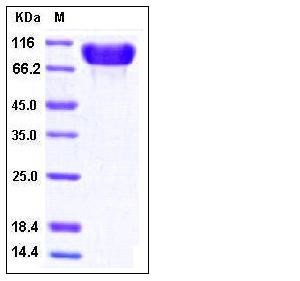Human Fibronectin / Fibronectin Fragment 2 Protein (His Tag)
CIG,ED-B,FINC,FN,FNZ,GFND,GFND2,LETS,MSF
- 100ug (NPP3866) Please inquiry
| Catalog Number | P10314-H08H |
|---|---|
| Organism Species | Human |
| Host | Human Cells |
| Synonyms | CIG,ED-B,FINC,FN,FNZ,GFND,GFND2,LETS,MSF |
| Molecular Weight | The secreted recombinant human Fibronectin 1 fragment2 (FN1.2) consists of 670 amino acids and has a calculated molecular mass of 73.2 kDa. As a result of glycosylation, rhFN1.2 migrates as an approximately 85-100 kDa band in SDS-PAGE under reducing conditions. |
| predicted N | Ser 607 |
| SDS-PAGE |  |
| Purity | > 97 % as determined by SDS-PAGE |
| Protein Construction | A DNA sequence encoding the Fragment 2 (Ser 607-Pro 1265) of humanFibronectin (CAD91166) was expressed with a C-terminal polyhistidine tag. |
| Bio-activity | Measured by the ability of the immobilized protein to support the adhesion of NIH-3T3 mouse embryonic fibroblast cells. When 5 × 10E4 cells/well areadded to CD4-coated plates (1.25μg/mL and 100μL/well),approximately 50%-80% will adhere specifically after 30 minutes at 37℃. |
| Research Area | Developmental Biology |Organogenesis |Skeletal development |Osteogenesis Markers |
| Formulation | Lyophilized from sterile PBS, pH 7.2 1. Normally 5 % - 8 % trehalose, mannitol and 0.01% Tween80 are added as protectants before lyophilization. Specific concentrations are included in the hardcopy of COA. |
| Background | Fibronectin (FN) is a glycoprotein component of the extracellular matrix of the extracellular matrix (ECM) with roles in embryogenesis, development, and wound healing. More recently, FN has emerged as player in platelet thrombus formation and diseases associated with thrombosis including vascular remodeling, atherosclerosis, and cardiac repair following a myocardial infarct. Each monomer of FN consists of three types of homologous repeating units, that is 12 type I repeats, two type II repeats and 15-17 type III repeats. The occurrence of multiple isoforms results from alternative mRNA splicing of the ED-A, ED-B and III-CS regions, and subsequent post-translational modification. As an ECM component and one of the primary cell adhesion molecules, Fibronectin can be a ligand for fibrin, heparin, chondroitin sulfate, collagen/gelatin, as well as many integrin receptors through which FN mediates the variety of cellular signaling pathways. The study of solid human tumors showed among the early signs of malignant transformation the fragmentation of pericellular FN, concommitent with the increase of its production by the peritumoral stroma. These results should encourage further investigations concerning the potential importance of Fn production and breakdown during cancer progression. FN1 expression has been described to increase significantly from the morula towards the early blastocyst stage, suggesting that FN1 may also be involved in early blastocyst formation. The fragment 2 of FN comprises the first 7 FN type III repeats and is suggested to be important for self association during fibril growth via the key module III2. |
| Reference |
